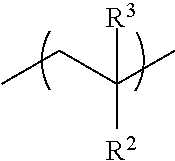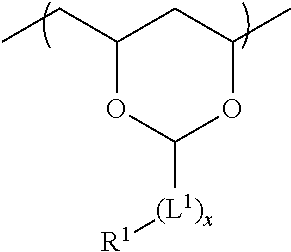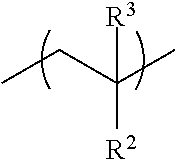(Ethylene, vinyl acetal) copolymers and their use in lithographic printing plate precursors
a technology of vinyl acetal and copolymer, which is applied in the field of vinyl acetal copolymer and lithographic printing plate precursors, can solve the problems of poor abrasion resistance of phenolic resins and poly(vinyl phenols), and cannot provide a high run length in such conditions, and achieves less susceptible to process conditions, high abrasion resistance, and high resistance to plate treating liquids
- Summary
- Abstract
- Description
- Claims
- Application Information
AI Technical Summary
Benefits of technology
Problems solved by technology
Method used
Image
Examples
examples
Synthesis of Inventive Resins 2 to 6 and Comparative Resin 1
[0146]The structural formulae shown below indicate the monomer composition of the prepared resins but the sequence of the moieties is for illustration only.
[0147]Unless otherwise specified, all compounds and solvents used in the Examples are readily available from fine chemical suppliers such as Acros or Aldrich.
Test Methods
LC-MS Analysis
Method 1
[0148]The LC-MS analysis according to method 1 was done on a HP 1100 Esquire LC, using an Altima HP C18 AQ column (150×3, 5 μm), operating at a flow rate of 0.5 ml / min and at 40° C. A gradient elution was used, with water+0.1% formic acid as eluent A and acetonitrile+0.1% formic acid as eluent B. The gradient according to the following Table was used.
[0149]
Time% B02071001710017.1202020
[0150]ESI ionisation was used in combination with a combibron detector. 5 μl of a solution of 2 mg of each compound in 10 ml acetonitrile was injected.
Method 2
[0151]The LC-MS analysis according to meth...
PUM
| Property | Measurement | Unit |
|---|---|---|
| mol % | aaaaa | aaaaa |
| mol % | aaaaa | aaaaa |
| mol % | aaaaa | aaaaa |
Abstract
Description
Claims
Application Information
 Login to View More
Login to View More - R&D
- Intellectual Property
- Life Sciences
- Materials
- Tech Scout
- Unparalleled Data Quality
- Higher Quality Content
- 60% Fewer Hallucinations
Browse by: Latest US Patents, China's latest patents, Technical Efficacy Thesaurus, Application Domain, Technology Topic, Popular Technical Reports.
© 2025 PatSnap. All rights reserved.Legal|Privacy policy|Modern Slavery Act Transparency Statement|Sitemap|About US| Contact US: help@patsnap.com



